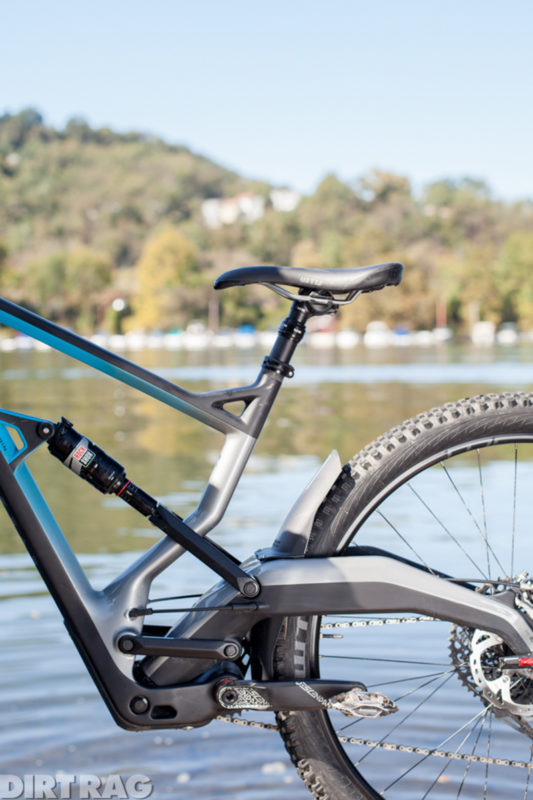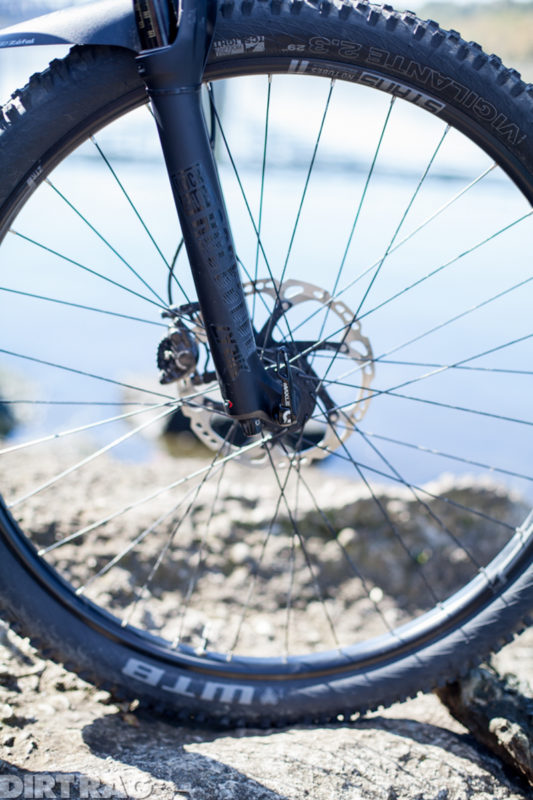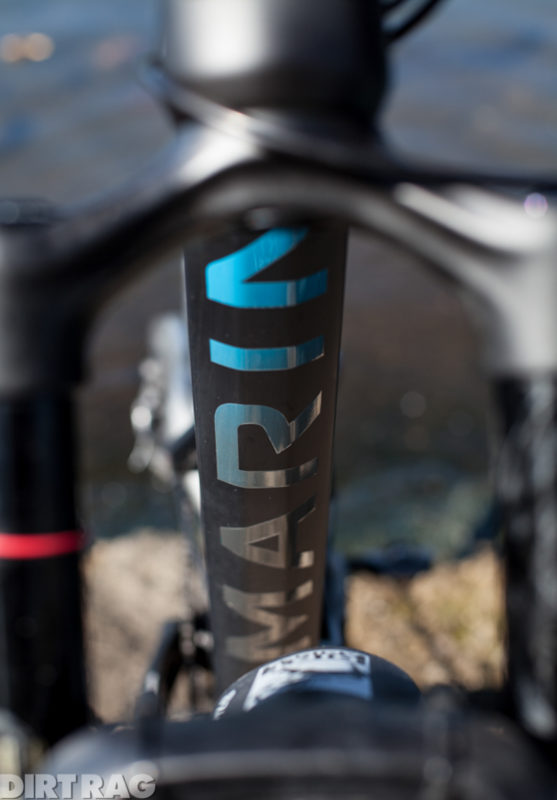Review: Marin Wolf Ridge 8
Originally posted on February 12, 2018 at 1:35 amTester: Eric McKeegan
Age: 43
Height: 5’11”
Weight: 165 lbs.
Inseam: 32”

Not since the launch of Kona’s Magic Link bikes (R.I.P) has there been a bike that creates such a sudden, visceral and polarized response. The Wolf Ridge is an ungainly looking conundrum of a bike, drawing questions of motorization and general confusion about whether this is a modern bike or something out of an almost-forgotten, elevated-swing arm past.
The bottom bracket area is the source of the majority of the confusion, housing a very low and very forward main pivot and the sliding stanchion at the heart of this new suspension system. Combined with a set of links, the R3ACT 2PLAY suspension system might look like an odd single pivot at first, but the axle path doesn’t follow a single-pivot’s basic arc.

Marin claims this bike pedals well enough that it defies standard categorization, separating suspension travel from category. Just how it pedals so well isn’t entirely clear, and both Marin and the suspension designer (Darrell Voss of Naild.it) aren’t forthcoming on what the secret sauce is behind the kinematics that point towards a new way of creating efficient bikes without relying on compression damping.
After few months on the bike, I had a multi-hour chat with Voss, dancing around the subject of how this bike works, with Voss never quite spilling the beans, although I started to develop a few theories behind what is going on. What is very clear is Voss’s goal of getting more people riding by making bikes that perform at the highest levels but don’t need expert-level suspension tuning skill to extract that performance. I was offered a peek behind the curtain if I signed a non-disclosure agreement, but I wanted to keep the review as honest as possible, so I declined until my time with this bike is finished.

The Bike
The last time I rode a high-end mountain bike without a lockout or platform lever of any kind was an Ellsworth from almost a decade ago. A few staffers rode that bike, and every single one, myself included, thought the bike needed one, terribly. The same cannot be said about the Wolf Ridge. The rest of the parts kit is what could be expected for a $5,000 bike, but the basic rebound-only RockShox Monarch is a sign of confidence in the design.
The rest of the bits on this carbon frame are well thought out. SRAM handles the GX Eagle 12-speed drivetrain; Shimano XT brakes do the stopping on 200/180 front/rear rotors, and WTB tires wrap up the latest NoTubes Flow rims.
The geometry is aggressive, but not fully in the long, low, slack category. The reach on a size large is “only” 462 mm; head angle is 66.5 and the bottom bracket is a low 13.2 inches. A slacker 73.5 virtual seat tube and a 15 mm offset dropper post keeps the cockpit roomy enough. A rear fender is included to protect that big, weird swingarm stanchion. (I have to say, I oddly enjoyed the cognitive dissonance that hit me as I was typing “swingarm stanchion”). Cable routing is internal, quiet and reconfigurable for brake or dropper preferences.

The Ride
Bike companies and media have long been claiming cross-country climbing performance from longer-travel bikes, even when it wasn’t remotely true. Enough times for a lot of consumers to think most of this type of talk is fake news, and I apologize for our part in that. But, put that aside. While I would dispute some of the claims that this bike could be raced competitively in a cross-country event, it does pedal better than anything of similar travel numbers.
But it isn’t just how well it resists bob, it is also how well the suspension still works, even when on the gas, standing to pedal or pedaling in tired, mashy squares at the end of a long day. The anti-squat numbers should explain some of that, but even bikes with similar numbers can’t come close to this performance without substantial low-speed compression assistance from the shock, which hampers small bump compliance.
This leads to an odd-feeling suspension when pedaling over difficult terrain, something I can best describe as hyperactive, yet controlled. Some of this is the result of running a faster-than-normal rebound speed, but on other bikes that just results in a bike that can start bouncing uncontrollably, something that isn’t the case for the Wolf Ridge.

I managed to ride this bike in a number of areas, from the steep trails of Santa Cruz to chunky and wet terrain in central Pennsylvania and West Virginia, to local trails and even a few commutes into work. Other than steep paved climbs, there never was a time I wanted a lockout. Since the bike pedaled so well, I rode it on a lot of rides that I otherwise would have picked a bike with less travel, although at 31 pounds it can feel like a lot of bike, a lot of the time. That 31 pounds doesn’t include particularly sturdy tires, so if you really want to take advantage of the capabilities of this bike, expect to add some weight for tires with a sturdier casing.
The handling is just flat-out neutral for a big bike. This isn’t a terrain-smashing 29er monster like the Transition Sentinel or Evil Wreckoning, but more along the lines of an incredibly capable trail bike like the Kona Process 153 29 or Specialized Stumpjumper 29.

There are a few minor issues to address. Front-end frame stiffness is spot on, but in some situations, the rear of the bike exhibited more flex then I expected. It wasn’t anything that would ruin the ride, and it was hard to really nail down if it was the swing arm or the very tall profile of the rear WTB Trailboss. Bottle mounts are non-existent. The extended frame in front on the bottom bracket could take a beating when smashing through rocky terrain. The plastic bash-protector is replaceable, and I would expect to do that at least once a season.
Marin claims a lot of things in its marketing materials for this bike, including (to paraphrase) that the Wolf Ridge is a paradigm switch where travel no longer defines bike category. This is a bit of a strawman argument, as no one seemed to solely use travel to define category, and with modern geometry, even short travel bikes can be ridden on terrain that would have been silly to attempt a few years ago.
The idea that someone smart like Voss did all the complex thinking for me on the back end to make my ride experience less complicated has some appeal. If this bike was released five years ago, it would have blown minds, but going head-to-head with similar modern bikes it is fighting for position at the front of the pack. This is no small feat for a smaller company like Marin, and the Wolf Ridge is a pretty special bike for the right rider.
With modern shocks becoming more and more complex, some riders will appreciate a bike with preeminent pedaling performance combined with simple suspension setup. The capable and neutral handling gets into and out of all kinds of messes, but all this technology comes at a price, and that price starts at $5,200 and tops out at $8,600 for the most expensive Wolf Ridge model.
As a one-bike quiver, the Wolf Ridge might be about as good as it gets for riders looking to tackle a huge range of terrian. A true omnivore of a bike, the Wolf Ridge moves from after-work rides to days in the bike park to backcountry slugfests with a grace and ease the belies its inelegant looks.

Specs (based on size tested):
Reach: 18.2”
Stack: 25”
Top Tube: 24.4”
Head Tube: 66.5°
BB Height: 13.2”
Chainstays: 17.1”
Weight: 31.1 lbs.
Price: $5,200
Sizes: S, M, L (tested), XL
